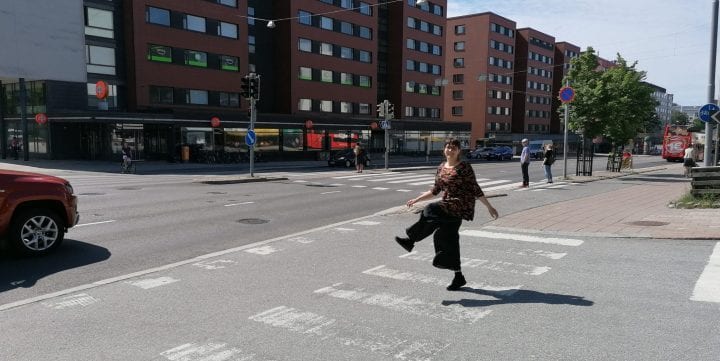The Playful City
The culture of play has changed and so has urban space. There are fewer kids running around courtyards and parks nowadays than before. Spontaneous free time has transformed into more organized activities and digital games move play from outdoors to indoors.
But playing has not disappeared anywhere. Play is still an important part of city life, culture, creativity – and humanity. Play does not belong only to children but also adults can play. Urban public space and its various elements offer countless playful possibilities for those who are ready to accept the challenge.
The materiality and sociability of urban space as starting points for play
People play in and with the city. But what is urban play and what makes it special?
Everyone has probably hopped on the black and white patterns of a zebra crossing, avoided stepping on the pavement gaps or blown dandelion seeds in an urban wasteland. The physical structures, materials and built environment in the city form basis for many different kinds of playful activities.
Parkour practioners and skateboarders are good at utilizing the physical structures of the city. Children, in particular, are capable of coming up with imaginary ideas of how to use street furniture, flower beds, park trees, snow and other “treasures” found on the roadside (sticks, rocks and broken items) in innovative new ways.
In addition to the material city, sociability is an essential part of urban space. In a city, one encounters with different people for better or for worse. This makes the city a special arena for play. Street performances, costume dressing (e.g. cosplay) and flash mobs happen in front of other people, and sometimes the audience ends up of being part of playful performances whether they wanted it or not.
Sometimes people may need some extra help to use the city in a playful manner, and therefore there exist different kinds of participatory urban games and art events. In fact, there is much in common with public art and urban play. Both art and play create new kinds of urban experiences but they may also annoy the fellow people in the city.
Once again, children are the experts and pioneers of social urban play. New games are developed and friendships formed among kids in parks and yards every day. For instance, I have met my best and oldest friend in our neighborhood playground at the age of 3.
Playing with meanings, rules and norms
A city is filled with different meanings and messages that one can play with. Children can easily imagine how a normal suburban yard becomes an island, castle or a familiar computer game world, what ever the play requires.
Marketing experts, on the other hand, use playful images when promoting and branding products, services or whole cities for potential customers, residents and tourists.
Gamification can be used in urban planning, when the aim is to develop more approachable and engaging methods for citizen participation. Mobile games based on augmented reality create whole new urban experiences as they combine the real world and the virtual world temporarily.
There are different rules and norms in the city that can be tested and stretched by playing. Some of these rules are written in law but there exist also many unwritten social norms and practices that, at worst, can increase urban injustice.
Urban play is about testing the boundaries of oneself and the city. Young people take over urban space in the ways comparable to play. Children do not care if their voices get too loud while playing.
Different understandings, hopes and interests regarding the “appropriate” uses of urban space can lead to conflicts and misunderstandings. Adults hush too noisy a play or forbid kids climbing on roofs or playing football in courtyards. Some prohibitions are necessary and justified in the name of safety but some only manifest the incapability of grown-ups to tolerate the freedom and anarchy of play.
Space and place for urban play
But how can urban play be advanced and cultivated equally and safely? It is crucial that parents and other adults give space, place and time for children’s play. It would not be bad either if adults went and played with the city themselves, too.
Play enhances creativity, helps with problem solving and is a medium for self-expression, and therefore enabling play in the society is important also in a wider sense. It is good to play at the work places as well.
Urban planners and architects can create spaces that inspire play. In addition to the traditional playgrounds and play areas, the city should encourage playful activities comprehensively.
Adequately dense, green and human-scale city offers a stimulating and child-friendly environment. In terms of social uses, urban space should be loose and versatile enough, if the aim is to enable human encounters in the city. Interesting details, multisensory experiences and urban art promote imagination.
A playful city is surprising and exciting but not scary. The primary thing is what kind of an attitude the users of urban space (that is, all of us!) have towards play. When have you hopscotched in a zebra crossing last time?
Riina Lundman
The text has been originally published in Finnish on the Play Day website of the Mannerheim League for Child Welfare’s (MLL) in June 2019. The Mannerheim League is the largest child welfare organization in Finland.

Photo: Virve Repo